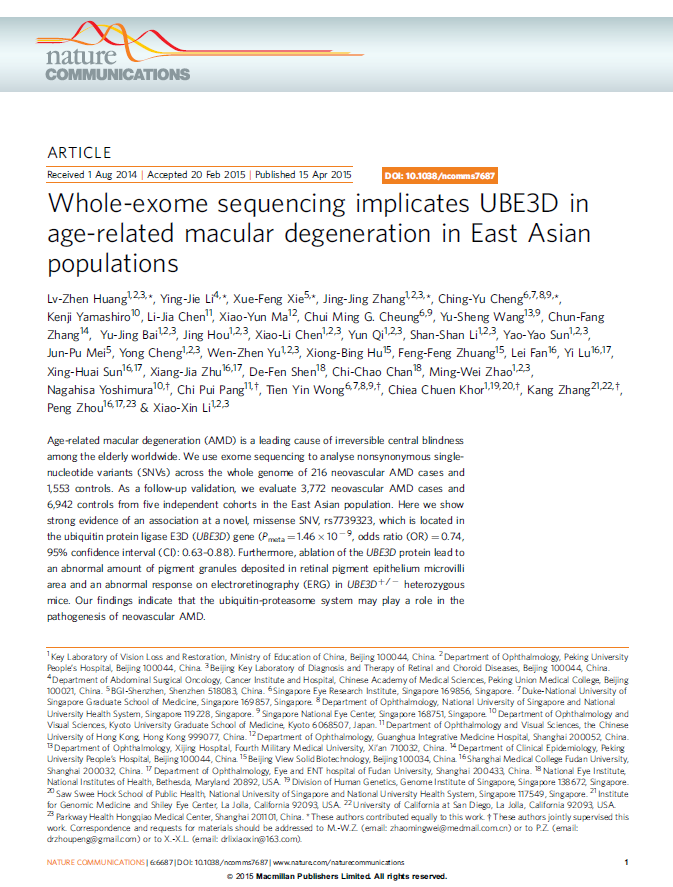
Author information
- 1
- 1] Key Laboratory of Vision Loss and Restoration, Ministry of Education of China, Beijing 100044, China [2] Department of Ophthalmology, Peking University People’s Hospital, Beijing 100044, China [3] Beijing Key Laboratory of Diagnosis and Therapy of Retinal and Choroid Diseases, Beijing 100044, China.
- 2
- Department of Abdominal Surgical Oncology, Cancer Institute and Hospital, Chinese Academy of Medical Sciences, Peking Union Medical College, Beijing 100021, China.
- 3
- BGI-Shenzhen, Shenzhen 518083, China.
- 4
- 1] Singapore Eye Research Institute, Singapore 169856, Singapore [2] Duke-National University of Singapore Graduate School of Medicine, Singapore 169857, Singapore [3] Department of Ophthalmology, National University of Singapore and National University Health System, Singapore 119228, Singapore [4] Singapore National Eye Center, Singapore 168751, Singapore.
- 5
- Department of Ophthalmology and Visual Sciences, Kyoto University Graduate School of Medicine, Kyoto 6068507, Japan.
- 6
- Department of Ophthalmology and Visual Sciences, the Chinese University of Hong Kong, Hong Kong 999077, China.
- 7
- Department of Ophthalmology, Guanghua Integrative Medicine Hospital, Shanghai 200052, China.
- 8
- 1] Singapore Eye Research Institute, Singapore 169856, Singapore [2] Singapore National Eye Center, Singapore 168751, Singapore.
- 9
- 1] Department of Ophthalmology, Xijing Hospital, Fourth Military Medical University, Xi’an 710032, China [2] Singapore National Eye Center, Singapore 168751, Singapore.
- 10
- Department of Clinical Epidemiology, Peking University People’s Hospital, Beijing 100044, China.
- 11
- Beijing View Solid Biotechnology, Beijing 100034, China.
- 12
- Shanghai Medical College Fudan University, Shanghai 200032, China.
- 13
- 1] Shanghai Medical College Fudan University, Shanghai 200032, China [2] Department of Ophthalmology, Eye and ENT hospital of Fudan University, Shanghai 200433, China.
- 14
- National Eye Institute, National Institutes of Health, Bethesda, Maryland 20892, USA.
- 15
- 1] Key Laboratory of Vision Loss and Restoration, Ministry of Education of China, Beijing 100044, China [2] Division of Human Genetics, Genome Institute of Singapore, Singapore 138672, Singapore [3] Saw Swee Hock School of Public Health, National University of Singapore and National University Health System, Singapore 117549, Singapore.
- 16
- 1] Institute for Genomic Medicine and Shiley Eye Center, La Jolla, California 92093, USA [2] University of California at San Diego, La Jolla, California 92093, USA.
- 17
- 1] Shanghai Medical College Fudan University, Shanghai 200032, China [2] Department of Ophthalmology, Eye and ENT hospital of Fudan University, Shanghai 200433, China [3] Parkway Health Hongqiao Medical Center, Shanghai 201101, China.
Abstract
Age-related macular degeneration (AMD) is a leading cause of irreversible central blindness among the elderly worldwide. We use exome sequencing to analyse nonsynonymous single-nucleotide variants (SNVs) across the whole genome of 216 neovascular AMD cases and 1,553 controls. As a follow-up validation, we evaluate 3,772 neovascular AMD cases and 6,942 controls from five independent cohorts in the East Asian population. Here we show strong evidence of an association at a novel, missense SNV, rs7739323, which is located in the ubiquitin protein ligase E3D (UBE3D) gene (Pmeta=1.46 × 10(-9), odds ratio (OR)=0.74, 95% confidence interval (CI): 0.63-0.88). Furthermore, ablation of the UBE3D protein lead to an abnormal amount of pigment granules deposited in retinal pigment epithelium microvilli area and an abnormal response on electroretinography (ERG) in UBE3D(+/-) heterozygous mice. Our findings indicate that the ubiquitin-proteasome system may play a role in the pathogenesis of neovascular AMD.
- PMID:
- 25872646
- DOI:
- 10.1038/ncomms7687